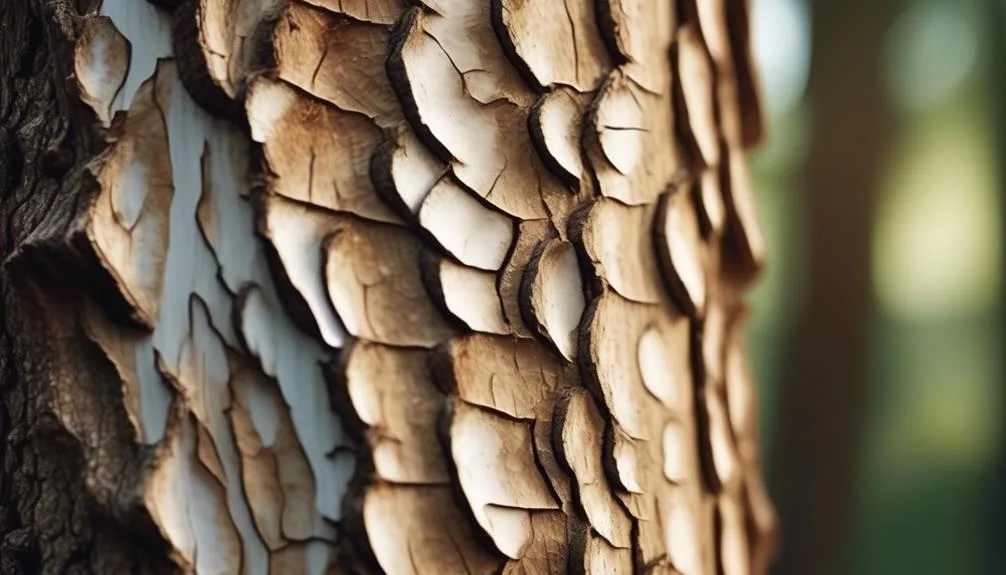Ever wondered about sycamore trees shedding their bark? Their patchy, peeling bark might puzzle you, but there's a fascinating reason behind it.
Understanding why sycamore trees shed their bark and what drives this process offers valuable insights into the natural world.
We'll uncover the mystery behind this intriguing phenomenon and explore its significance for these majestic trees.
Sycamore Bark Shedding Process
As sycamore trees enter their shedding season, the bark begins to peel away in large, papery sheets, revealing the smooth, pale inner layers underneath. This shedding process is essential for the tree's health as it allows for bark regeneration.
As the old bark flakes off, it makes way for new, healthy bark to form, ensuring the tree's protection against pests, diseases, and environmental stressors. The shedding also plays a crucial role in maintaining the tree's ability to exchange gases, absorb water, and protect itself from extreme temperatures.
Without this natural shedding process, the tree's bark could become damaged and compromise its overall health. So, next time you see a sycamore shedding its bark, appreciate the intricate process that contributes to the tree's well-being.
Reasons for Sycamore Tree Bark Shedding
Sycamore trees shed their bark for several reasons, contributing to their overall health and vitality. Bark shedding is a natural process that allows the tree to maintain its well-being. The shedding of old bark helps sycamore trees to get rid of accumulated pests, diseases, and environmental pollutants, promoting better tree health. Additionally, shedding bark allows for the renewal of the tree's protective layer, enabling it to better withstand harsh weather conditions and potential damage. Below is a table summarizing the key reasons for sycamore tree bark shedding.
| Reasons for Sycamore Tree Bark Shedding |
|---|
| 1. Removal of pests and diseases |
| 2. Elimination of environmental pollutants |
| 3. Renewal of protective layer |
| 4. Enhanced resistance to harsh weather |
| 5. Promotion of overall tree health |
Benefits of Sycamore Tree Bark Shedding
Shedding bark offers sycamore trees a range of benefits, contributing to their overall health and vitality by promoting renewal and resistance, and enhancing their capacity to withstand environmental stresses.
As the old bark peels away, it helps the tree get rid of accumulated pests, diseases, and environmental toxins, allowing for a fresh, clean surface. This shedding process also enables sycamore trees to heal wounds and prevent the spread of infections.
The exposed inner bark is rich in nutrients, providing a food source for insects, fungi, and other organisms, which contributes to ecosystem support.
Additionally, shedding bark allows the tree to grow and expand, preventing constrictions that could hinder its development.
Environmental Factors Influencing Bark Shedding
When considering the factors that influence the shedding of bark on sycamore trees, the local climate and soil conditions play a significant role in determining the frequency and extent of this natural process.
The bark shedding cycle of sycamore trees is greatly influenced by environmental factors. In regions with high humidity and ample rainfall, sycamores tend to shed their bark more frequently. The moisture in the air softens the outer bark, making it easier for the tree to shed.
Conversely, in drier climates, the bark shedding process may occur less often. Soil conditions also impact bark shedding, as nutrient-rich soil can promote healthy bark renewal. Additionally, environmental factors such as temperature fluctuations and exposure to sunlight can also have a notable environmental impact on the bark shedding cycle of sycamore trees.
Managing Sycamore Bark Shedding
Managing the shedding of bark on sycamore trees involves implementing strategies to optimize environmental conditions and promote healthy bark renewal, ultimately influencing the frequency and extent of this natural process. Proper tree maintenance and landscaping techniques can significantly impact the bark shedding patterns of sycamore trees.
| Strategies for Managing Sycamore Bark Shedding | Benefits |
|---|---|
| Regular pruning of dead branches | Promotes healthy bark growth and renewal |
| Mulching around the base of the tree | Helps maintain consistent soil moisture levels |
| Monitoring tree for pests and diseases | Prevents infestations that can weaken the tree |
| Providing adequate water and nutrients | Supports overall tree health and vitality |
| Protecting the tree from mechanical damage | Reduces stress and promotes steady bark shedding |
Conclusion
In observing the shedding of sycamore tree bark, we witness nature's cycle of renewal and resilience.
This natural process not only sustains the tree's health but also supports the environment and wildlife.
Perhaps it prompts us to consider the beauty and purpose in the continual transformation of the world around us.

My interest in trees started when I first saw the giant sequoias in Yosemite.
I was a teenager then, and I remember thinking, “I need to learn more about this.”
That moment stuck with me.
A few years later, I went on to study forestry at Michigan Tech.
Since graduating, I’ve worked in a mix of hands-on tree care and community education.
I’ve spent over ten years helping people understand how to plant, maintain, and protect the trees in their neighborhoods.
I don’t see trees as just part of the landscape.
They are living things that make a real difference in our daily lives.
